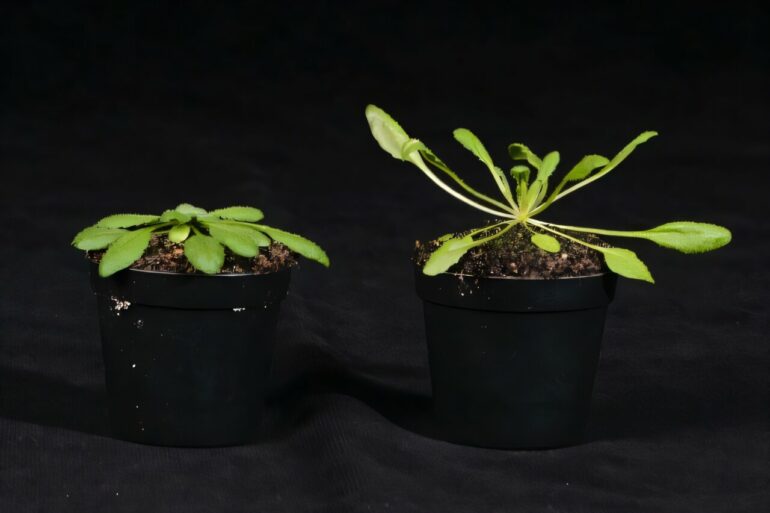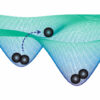Plants that are close together do everything they can to intercept light. This “shade avoidance” response has been extensively researched. It is therefore even more remarkable that researchers from the laboratory of Molecular Biology at Wageningen University have discovered another entirely new mechanism: the important role of the hormone cytokinin.
Their research has been published in Nature Communications.
Plants in nature, in the field or in the greenhouse compete with each other for light, moisture and nutrients. The more densely planted they are, the tougher the competition. But how do they know they are getting a bit crowded?
“In densely planted crops, red light is absorbed faster than far-red light, which is instead reflected. The red-to-far-red ratio therefore decreases with greater density. Plants ‘see’ this through the light-sensitive pigment phytochrome,” says Ronald Pierik, professor of molecular biology at Wageningen University & Research.
The pigment is like a switch: it can be active or inactive. The red-to-far-red ratio operates the button, so to speak. That sets off a whole series of responses.
Pierik says, “With relatively high levels of far-red light, as is the case in densely planted crops, the stems grow longer, as do the petioles. The leaves themselves move from a horizontal to a more vertical position. Anything to rise above their neighbors and intercept more light.”
Aboveground and underground competition
Much is already known about this response and the mechanisms that drive it.
“How plants process information relating to light is important for our crops. Because we always plant them close together. The question is how far you can go,” says Pierik.
However, plants not only compete for light but also for nutrients, for example.
“You should therefore consider shade avoidance in conjunction with other responses to competition. You would then get much closer to the situation in the field. This line of thinking led our postdoctoral researcher Pierre Gautrat, who started this work in our former group at Utrecht University, to the idea of examining aboveground and belowground competition in conjunction. One of the research questions was whether the plant, if it does not receive much nutrition in the form of nitrogen, can still respond well to far-red light,” he says.
Cytokinin serves as a messenger
For this, the growing tissues need to know how much nitrogen is available in the soil. They know that because a message passes from the roots to the growth points. In this case, the messenger is the plant hormone cytokinin. This hormone is formed in the roots and passes through the veins to the part of the plant that is above ground. If there is a large amount of nitrogen present, there will also be lots of cytokinin.
“In fact, the shade avoidance response appears to be inhibited when nitrogen is low. However, we have demonstrated that you can actually trick the plant. If you give it extra cytokinin, when nitrogen is low, you still get substantial length growth with extra far-red light. This is the first time that anyone has shown that cytokinin plays a role in shade avoidance. We have therefore discovered a new mechanism. This is quite remarkable, because these processes have already been studied very intensively,” says Pierik.
And it gets even more remarkable: Until now, cytokinin was known to be the very hormone that inhibits length growth. “Looking back, all the trials on which that conclusion was based involved seedlings raised in the dark. You only get that response when you grow them in the light. And not with ordinary white light, but only with an excess of far-red light,” he explains.
The inhibitor inhibited
The researchers also investigated how this mechanism works at the genetic level.
“There are specific proteins that inhibit plant sensitivity to cytokinin. The genes encoding these proteins are themselves inhibited when exposed to far-red light. In other words, the inhibitor is inhibited. And that is precisely what stimulates sensitivity. These are also very new insights,” Pierik says.
The architecture of crops can be very important.
“We learned that from the Green Revolution. That resulted in much higher yields because agronomists started growing rice and wheat varieties that put less energy into length growth and more into the grains. Such new insights can help agronomists and growers achieve better production in crops like barley, wheat, maize and rice,” he concludes.
More information:
Pierre Gautrat et al, Phytochrome-dependent responsiveness to root-derived cytokinins enables coordinated elongation responses to combined light and nitrate cues, Nature Communications (2024). DOI: 10.1038/s41467-024-52828-y
Provided by
Wageningen University
Citation:
How plants compete for light: Researchers discover new mechanism in shade avoidance (2024, October 21)



